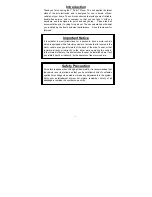
15
• Insert the Bipolar male plug into the Bipolar Handpiece receptacle on the front panel.
• Select Coagulation Mode by selecting the desired power level.
• Depress the "COAG" Footswitch controller to activate the output power.
This function can only be activated with the foot pedal.
VI. CLINICAL INFORMATION AND PRACTICING PROCEDURES
6.0
CLINICAL INFORMATION AND PRACTICING PROCEDURES
6.1
LEARNING TO USE RADIOSURGERY
Before making contact with the tissue, the power intensity must be selected and the Foot pedal or
fingerswitch must be activated. During the actual cutting, it is important to use a smooth uninterrupted
motion with even and light pressure. The movement should not be too slow. If it is, the build-up of lateral
heat in the tissue may cause charring, followed by necrosis and sloughing (see Preoperative Cutting
Practice). When performing a second or third cut in the same surgical site, allow approximately ten
seconds for the tissue to cool between applications of the electrode to the site. Radiosurgery should not
be regarded as a totally new art that will require learning of old skills. All rules of good surgical technique
and clinical judgment still apply. The biggest difference, and the most important thing to be learned is
that radiosurgery cuts without pressure, unlike the steel scalpel, and so a light, smooth, continuous
brush-like stroke should be developed. Only then will the surgeon really appreciate the tremendous
advantages inherent in radiosurgery.
6.1.1
Defining Good Technique
Radiosurgery can create tissue damage if the heat is allowed to accumulate in the tissue to the
point where excessive dehydration occurs and the tissue is destroyed. Preventing the
accumulation of such heat is the basic objective of radiosurgical technique. The accumulation of
lateral heat in tissue depends upon various factors as indicated in the following formula:
Time Which Electrode
Intensity of
Electrode
Nature of
Contacts Tissue
x
Power
x
Size
x
Wave
Lateral Heat =
Frequency
This formula may be broken down in the following manner:
A. Electrode Contact Time
a. The slower the passage of the electrode, the greater the lateral heat.
b.The more rapid the passage of the electrode, the less the lateral heat.
B. Intensity of Power
a. Intensity too high - high accumulation of lateral heat, due to sparking.
b. Intensity correct - lateral heat reduced to the minimum necessary to volatize tissue cells.
Smooth flow through tissue with no sparking and no resistance through tissue.
c. Intensity insufficient - high accumulation of lateral heat due to drag. Also excess bleeding
due to drag or tissue being pulled and torn from its base.
C
Electrode Size
a. The larger (or thicker) the electrode, the more lateral heat produced and the higher the
power setting necessary to operate.
b. The smaller (or thinner) the electrode, the less lateral heat produced and the lower the
power setting necessary to operate
D
Nature of the Waveform -
See Section 6.2 for details
a.Equivalent Fully Rectified Filtered (Continuous Wave - CW) - Least lateral heat.













































